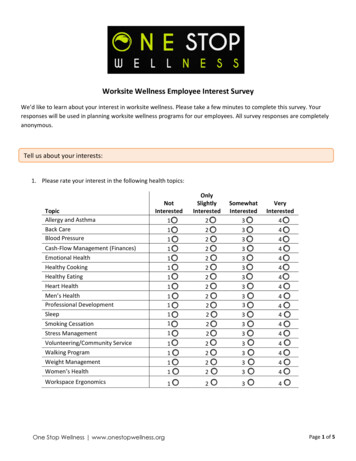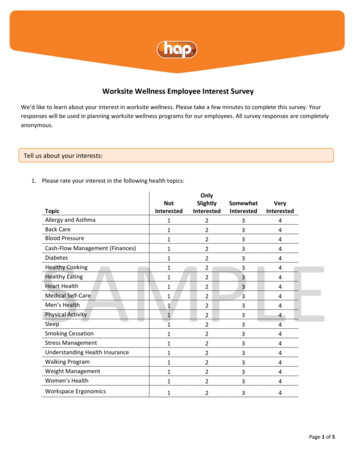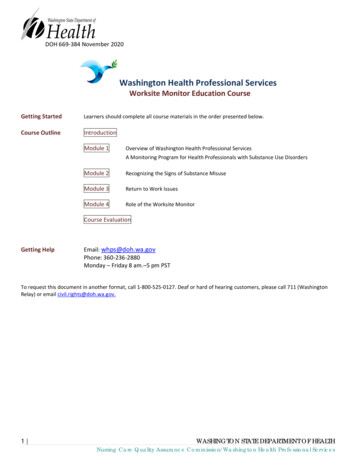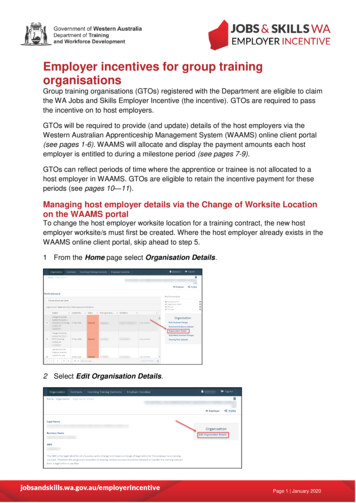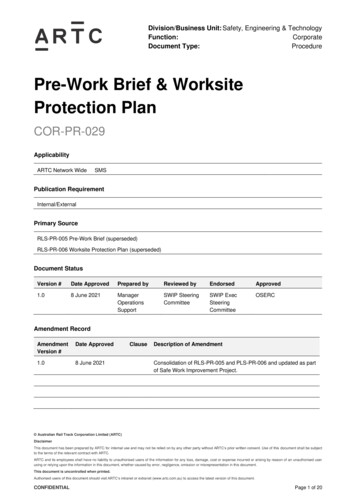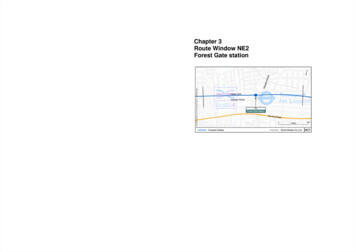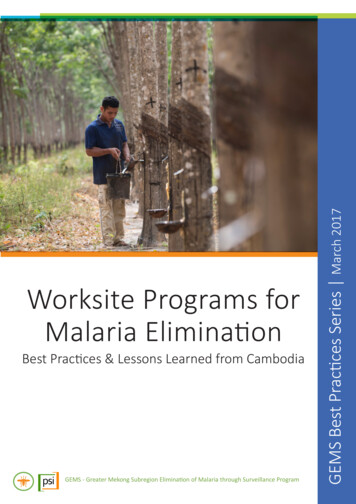
Transcription
Best Practices & Lessons Learned from CambodiaGEMS - Greater Mekong Subregion Elimination of Malaria through Surveillance ProgramGEMS Best Practices Series March 2017Worksite Programs forMalaria Elimination
2 GEMS Program
Copyright by Population Services International 2017Graphic Design: Julia Driscoll (juliadriscolldesign.com)Photos: Damien Schumann (dspgallery)The GEMS program is funded by the Bill & Melinda Gates Foundation.GEMS Program 3
4 GEMS Program
ContentsRationale: Why worksites matter07Mapping & Site Selection09Advocacy & Set Up10Malaria Worker Selection11Stakeholder Orientation12Malaria Worker Training13Working with Malaria Workers14Quality Assurance17Improving Testing Rates19Reporting20GEMS Program 5
6 GEMS Program
1Rationale: Why Worksites MatterMalaria elimination requires finding and treating every lasttransmittable case of malaria, and this means ensuring thatthose most at risk have rapid access to testing and treatmentservices. As the vector breeds in forests in the GreaterMekong Subregion (GMS), communities who live and workin forested areas are key groups. For transient workers whoseek work in these areas, many of whom do not have theknowledge, language, paperwork or comfort-level to seekprofessional medical care when they are on-the-move or onsite, their risk of malaria infection is compounded by a lack ofaccessible health services. Providing quality assured healthservices to these workers – often in remote areas – is alsochallenging.Worksites including dams, mines and construction sites attractmobile migrant populations (MMPs), and are frequentlylocated close to forested areas with evidence indicating thatmature rubber plantations also provide favorable conditionsfor transmission. For worksites at a distance from forest, therisk of infection comes from mobile workers in search of workarriving from the endemic areas. Worksites therefore presentan excellent opportunity to reach this moving population ofworkers with malaria services.In 2013, Population Services Khmer (PSK) launched itsmalaria worksite program on 45 plantations in five malariaendemic provinces. By the end of 2016, the program wasactive in 131 plantations in seven malaria endemic provinces,with 202 embedded, stocked and trained malaria workers.This document summarizes the program’s key learnings andrecommendations.Worksite Program Objectives1To support the National Malaria Control Programs to eliminate malaria among workers residing in or nearplantations and other worksites;2To closely collaborate with plantation owners/managers to promote and protect their workers’ health.GEMS Program 7
8 GEMS Program
2Mapping & Site SelectionIn Cambodia, PSI/PSK launched its worksite program in 2012with a national full census survey that screened over 1,450enterprises, conducting in-depth interviews at 571 worksites,which together employed nearly 98,000 workers. Informationwas collected on health services on site or in the vicinity,the accommodation provided to permanent and seasonalworkers, the type of crops grown, the owner’s nationality,and seasonal peaks in workers. Worksites were interviewed ifthey had more than 80 workers on site, on the basis that thisrepresented a medium-sized workforce where the logistics toset up test-treat-track services would be cost-effective. Sitesselected for inclusion in the program were determined by: Number of workers on site (80 or more) Presence of risk factors, including:· Proximity to a forest· Low availability of quality health serviceson site or in the immediate vicinity, including malariatest and treatment services Willingness of the owner/manager toparticipate in the program.GEMS Program 9
3Advocacy & Set UpSuccessful worksite programming depends on a mutualunderstanding and good relationships with: (a) ProvincialHealth Departments and other relevant governmentauthorities, (b) Worksite owners/managers, (c) the embeddedmalaria worker (MW), and (d) the MW’s supervisor. Aftersecuring government support, PSI carries out three visitswith the worksite owner or manager to gain approvaland build trust and good collaboration to ensure smoothimplementation.Advocacy Tips1Good communicationCall ahead to arrange visits at a convenienttime for the worksite, and confirm. If delaysor changes are expected, communicate thisas soon as possible. Clear messaging andtransparent communication in particularhelps to gain access to unregistered worksiteswho may be wary of outsiders.2Involve SupervisorsIncluding the MW supervisor builds supportfor the MWs additional responsibilities, e.g.taking time to visit sick workers or attendtrainings.3Health WorkersMessages to the worksite owners/managersthat have proven most successful havefocused on “Helping You to Keep YourWorkers Healthy!”The distinct purposes of the three visits are to:1. Build an understanding between worksite owners andthe program on program rationale, benefits andclarify mutual expectations.2. Recruit Malaria Workers who will subsequently bestocked, trained and supported.3. Invite owners/managers, MW's and their supervisorsto a training workshop.10 GEMS Program
4Malaria Worker SelectionThe success of the program depends on the availability,commitment and skill of the MWs, and this begins with goodrecruitment. PSI recruits one to three workers depending onthe size of the site.Recruitment Tips1PositioningPSI has found that MWs who are already regard edas leaders on site or have other key responsi bilities(e.g. salary distributors) are particularly effectiveMWs, as they are well known and tend to movearound the site more.2CommitmentPSI’s highest performing MWs are those who feela deep personal commitment and pride in beingable to help others and improve the health ofthose around them.3CuriosityAn interest in learning and a natural curiosity aregood traits to look for in a MW.Minimum criteria for recruiting Malaria Workers Able to read and write Khmer. Authorized by the worksite manager/owner to work asa Malaria Worker. Supported by his/her direct supervisor to work as aMalaria Worker. Committed and willing to provide malaria care to his/her fellow workers. Able to use a basic smart phone. Part of the permanent staff on the worksite. Agrees to work for a minimum fee.GEMS Program 11
5Stakeholder OrientationMutual understanding, trust and good communicationare important factors for a successful worksite program. Aformal half-day workshop is recommended for the worksiteowners/managers, MWs and their supervisors to build aclear understanding of PSI and its Malaria Worksite Program,and the roles and responsibilities of worksite management,the MWs — and PSI. This understanding is formalizedby the signing of an agreement between the worksiterepresentatives and PSI to officially outline the collaboration.12 GEMS ProgramOrientation Tips1Government participationInviting relevant government representativesfrom the NMCP, and appropriate localgovernment departments, such as health,labor, training and commerce is key in lendingadditional weight and officially recognizingeach partners’ commitment in public.2MW recognitionProviding new MWs with a physical symbolof their new role (e.g. a t-shirt, cap, raincoat,certificate etc.) can go a long way to buildingthe pride and commitment of a strong MW.Certificates signed by the government can alsobe a powerful tool.3Social interactionA workshop dinner is a great opportunityto allow the worksite, government and PSIrepresentatives to get to know each othersocially and build relationships.
6Malaria Worker TrainingAs MWs often have very little medical experience and have varied educational backgrounds, training isa critical step to ensure that they understand their responsibilities and are able to perform them withconfidence and to the standard required.To Test, Treat and ReferTo Provide ClearInformationTo Collect Data Your job is to test everyperson who comes to youwith fever using a RDT. Your job is to instruct allpositive cases to take the full3 day course of drugs. Your job is to keep themalaria drugs and tests in asafe, dry place. Your job is to treat thepositive cases with thecorrect drug. Your job is to explain toworkers the benefits ofsleeping under a treated netevery night. Your job is to clearly recordeach patient seen in theMalaria Patient Register. Your job is to refer anypregnant women, childrenunder 5 years old, or peoplewith symptoms of severemalaria to the nearest healthfacility. Your job is to give theMalaria Patient Register to aPSI staff member monthly. Your job is to explain whydrug cocktails are dangerousand do not make the patientwell again.Malaria Case ManagementThe PSI training ensures that MWs can recognize malariasymptoms and assess danger signs, can correctly and safelyuse an RDT, read the test results, dispense the appropriateantimalarial drug with proper counseling to the patient to (a)complete the full 3-day course, (b) return if symptoms persistor worsen, and (c) prevent malaria by consistently sleepingunder a treated net. Accurate and complete case reporting,either on paper and/or smart phone, is also a vital part ofthe training, as is correct completion of referral slips anddirections for severe cases. As cases drop, treatment andadvice for non-malaria fever is now being added.Are you working in the forest or plantations?You are at risk of Malaria!If you have a feverALWAYSget tested FIRST!If positive only take MOHrecommended drugCOMPLETE the full3 days courseNEVER take cocktailsfor MalariaProtect Yourself from Malaria, Always sleep under a treated net!GEMS Program 13
7Working with Malaria WorkersInformed, motivated and engaged MWs will be the most effective and reliable attesting and treating malaria appropriately, and reporting their data accurately andregularly. A worksite program can support its MW volunteers in a number of wayswhich will underpin the program’s success.Appropriate IncentivesMWs are volunteers, however material incentives are appreciated and PSI provides support in the followingways: Phone credit and 15 stipend for performance-based results, e.g. at least 5 tests conducted and reportedeach month Material recognition, such as t-shirts, caps, raincoats, and certificates. Signs or stickers that the MW can use to promote their location and services.Incentives should be in line with government policies, as well as any incentives provided by other implementingpartners working with volunteers on worksites and elsewhere to ensure the system is consistent and fair.14 GEMS Program
Supervisor support MWs report that an important factor in their effectiveness and enjoymentof their responsibilities is having the support and understanding of theirsupervisor. This may include offering more flexible working hours to allowthem to visit patients or to attend training workshops.Supervisory support visits At least one visit per month ensures that MWs feel supported andhave a chance to ask questions and receive updates. Support visits should also include intermittent quality assessments onthe MW’s skills and the care they are providing.Refresher training Following the initial training, annual refresher training is recommended tokeep skills sharp, and bring MWs from different worksites together again. Thisallows them to share experiences, and creates a comaraderie as well as somehealthy competition. The distribution of visual job aids on correct RDT use and ACT dosage byage or weight, as well as recognizing danger signs are key to help each MW’slearning curve and serve as a useful reminder aid.Trusted supply chains MWs cannot work without a secure, uninterrupted and regular supplyof malaria RDTs and ACTs. Regular stocking is absolutely critical. Providing other health products is also recommended, includingcondoms, ORS plus zinc and basic first aid kit supplies.GEMS Program 15
8Quality AssuranceThe Quality Assurance AppPSI’s Health Network Quality Improvement System (HNQIS),is a tablet-based app for staff to plan, assess, monitor andcontinually improve the quality of care provided throughnetworks of providers. A malaria HNQIS was rolled out inCambodia in late 2016, and also in Lao and Myanmar in early2017.The app is used during supervisory support visits and usinga checklist, the provider is scored as he/she takes care of apatient suspected of having malaria, or by simulating a case.The following key areas of correct case management areassessed with a standard inbuilt feedback script to highlightwhy it’s important to test, why it’s important to correctly fillout a report for each positive case etc. Recognition of severe malaria symptoms Correctly using an RDT Prescribing treatment according to national guidelines Appropriate patient counseling Work place assessment.Remember!Assessments are used to help the MW to continuallysharpen their skills. They are not a “test.” PSIteams report that assessments result in fasterimprovements in quality when the provider feelsrelaxed and supported. They are also a usefulopportunity to help PSI staff learn more about theconstraints that the MW is working under in orderto improve support to the MW.16 GEMS ProgramEmerging IdeasBased on its experience to date, PSI is consideringsome new ideas to continue to improve providerservice quality. An incentive for increasing scores, recognizinggood performers and promoting friendlycompetition? A worksite-based QA score based on LLINcoverage, BCC, support for the work of MWs? A help line to call with any questions on the QAapp?
Quality Assurance TipsPSI’s quality assurance component rests on the following principles:PartnershipAssessments are carried out in the spirit of support, learning, mutual understanding and ensuring thebest possible health care is provided to the patient. They are not done to penalize the MWs.Regular assessment against best practicesAssessments are objective (not subjective) measurements against standardized best practices.Immediate feedbackA belief that learning happens best when positive feedback as well areas needing improvement isprovided immediately after an assessment is completed.Benchmark performanceAs all assessments use the same measures, MWs can be categorized into Class A (high), Class B(average) and Class C (poor) to track the quality of service across a full network and how this changesover time.Tailored supportBenchmarking providers allows the program to concentrate on behaviors that need improving andsupport visits can be more efficiently scheduled (for example, an A-class provider does not need visitingevery month).GEMS Program 17
18 GEMS Program
9Improving Testing RatesThe goal of setting up services on worksites is to test and treat as many cases as possible.Pro-actively creating opportunities to boost testing rates has been found to be important andthe following five ideas are ways that PSI has successfully increased testing rates from 2013 to 2016.21Link incentives to testingWhile testing suspected cases wasalways a key responsibility of a MW’swork, incentivizing the MW to testby linking their monthly stipend to aminimum of five tests in the last monthhas proved very successful. It should benoted that as malaria cases fall, someMWs may see very few suspectedcases, but this approach encourages amore pro-active ‘get out there and lookfor suspected fever cases’ behavior.4Integrated health servicesAs malaria drops across the region,malaria services alone do not ensurethe relevance of the MWs. By offeringother services that are in demand onthe sites, MWs have the opportunity toalso offer malaria BCC messages, andother screening services. Additionalhealth services should be determinedin consultation with the worksite,PSI’s strengths, the country’s policiesand may include reproductive healthproducts, treatment for diarrhea,colds, headaches and basic first aid.Suspected Malaria FeverCases Tested2013501Screen and treat on arrivalWorksite owners are being encouragedto test workers as they arrive on siteand provide BCC messages as wellas alert them to the fact a MW is onsite providing free malaria and otherservices. Screening and treating workersas they arrive (and exit if possible)means “malaria free” worksites areprotected from re-infection and onwardtransmission to other sites, is reduced.3De-worming daysDe-worming days are an easy, safe andinexpensive way to attract workersand their families to receive a popularservice and create an opportunityto offer voluntary malaria screeningand treatment. In 2016, PSI/PSKconducted two deworming campaignsin all plantations, which tested 2,928workers, and found 11 positivecases. This may sound low, but in anelimination setting, every case counts.5Cash for fevers20141,14120152,34220164,947An innovative system which offersworkers with fevers to get tested bygiving them a small cash incentive isbeing piloted with an additional cashincentive if they bring co-workers orfamily members to be tested who mayalso be at risk.GEMS Program 19
10ReportingReporting every single case back to PSI/PSK is vital to ensureeach positive case reaches the NMCP’s national database.The reporting system needs to strike a balance between beingtimely, accurate and robust – and being user-friendly for theMW to maintain on a regular basis. PSI recently switchedfrom paper to phone app reporting, and the transition so farhas been smooth, with data entering directly into PSI’s DHIS2database for analysis and a verification period to comparethe app data against the paper records and cross-checkingwith the used RDTs.Reporting Tips1Training and supportProvide initial and regular refresher training on how to correctly report and why it’s so important. Use regularvisits to check any regular reporting errors that need fixing. Ensure that the MWs understand why each piece ofinformation is being collected, and its significance to the national elimination strategy.2Simple systemsKeep documents and the number of data fields to a minimum to reduce the time burden and opportunities forerror. A phone app can make the process simpler and less burdensome.3Incentivize reportingLink a material incentive system with the data reporting, e.g. payment of stipends.4VerificationEnsure that staff have a way to verify data reported, e.g. through checking any paper records or counting used RDTs.5Feedback loopsGive MWs a way of seeing the data that they have reported so that they know their data is important and does notdisappear into a big black hole!20 GEMS Program
Key Takeaways1AdvocacyBuild a transparent and trust-based relationship with worksite owners/managers from the beginningand maintain open communication lines by responding to questions quickly and by providing answersthat make sense to them.2RecruitmentEnsure that selected MWs are reliable, trusted and motivated workers who will maintain committedto their responsibilities, and have the support of their supervisor.3Training and supportProvide initial and ongoing training and support to MWs to ensure they feel valued, confident andmotivated throughout their engagement.45Quality assuranceUse standardized quality assurance assessments as an opportunity to improve provider performanceand sustain their commitment to learning.Increase testingEmploy a variety of activities and approaches appropriate to each worksite to build and maintain thevisibility, relevance, accessibility and reliability of the MWs’ services to all worksite workers.GEMS Program 21
What is GEMS?GEMS is a PSI program that partners with the National Malaria Control Programs inCambodia, Lao PDR, Myanmar and Vietnam to strengthen case management andsurveillance in the private sector to accelerate each country’s progress towardstheir ambitious malaria elimination goals. GEMS brings together PSI’s longstandingexperience working with the private sector in the region, malaria achievementsglobally, cutting edge technological tools, a solid logistics infrastructure, strategicpartnerships, and a new thinking in disease surveillance. GEMS is supported by theBill & Melinda Gates Foundation.Mapping private sector health care providers and worksites attractingmobile workers.Comprehensive training and routine supervision to ensure high qualitymalaria care and data reporting.Securing supply chains for quality assured RDTS and firstline treatments.Establishing routine reporting systems for all suspected and confirmedcases and promoting data use.Actively finding and investigating cases and contributing tomolecular surveillance.G E M S C O N TA C T SLorina McAdamDirectorLmcadam@psi.orgRebecca PotterRegional Evidence & Monitoring Advisorrebecca@psi.orgStephen PoyerResearch Advisor, Malaria & Child Survivalspoyer@psi.orgCONNECT WITH USpsi.org facebook.com/PSIHealthyLives
malaria worksite program on 45 plantations in five malaria endemic provinces. By the end of 2016, the program was active in 131 plantations in seven malaria endemic provinces, with 202 embedded, stocked and trained malaria workers. This document summarizes the program's key learnings and recommendations. 1 Rationale: Why Worksites Matter 1 2





